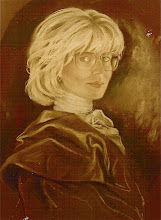 Meeting John Paul II was a life-changing experience. There was an unusual force that just emanated from his presence. When painting his portrait, I was in an altered state, seemed like in a trans of submission. The portrait came about practically without my participation. All lines and colors practically placed themselves. I had no control over my hand. It seemed remotely directed by some kind of a force. After finishing, I wanted to make a smaller copy for Father Dziwisz, but it didn't come out well. Until today, I do not know how was it possible.
Meeting John Paul II was a life-changing experience. There was an unusual force that just emanated from his presence. When painting his portrait, I was in an altered state, seemed like in a trans of submission. The portrait came about practically without my participation. All lines and colors practically placed themselves. I had no control over my hand. It seemed remotely directed by some kind of a force. After finishing, I wanted to make a smaller copy for Father Dziwisz, but it didn't come out well. Until today, I do not know how was it possible.I was privileged to portray His Holiness The Pope John Paul II in the Vatican, on the 17 November 1999. The sitting took place thank to the efforts of Lady Belhaven and Stenton, who is a close friend of Bishop Stanislav Dziwisz, then the assistant to the Pope. She is the one, who has arranged and organized the miracle.
The portait was liked at the Vatican so much that I was commissioned to paint two more portraits of the Pope soon afterwards. Upon returning to London, we printed thousands of cards with the painting. They were being sold among followers. This way we raised funds for the General Sikorski monument in London. On the 29th of November, the day of my birthday, I received a letter written by the Secretary of the State of Vatican:
"Dear Madam, On behalf of His Holiness The Pope John Paul II we thank you for the gift of having painted His portrait. I wish to asure you that the portrait has been very highly valued by many and is liked by all. The Holy Father refers you and your family to Divine Providence and is blessing you for further artistic work. Yours sincerely, ArchBishop Giovanni B."
Published by Evita Ramparte





